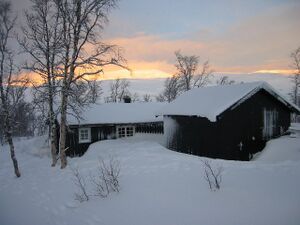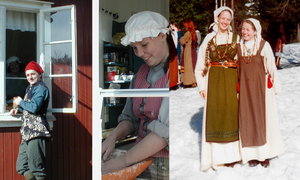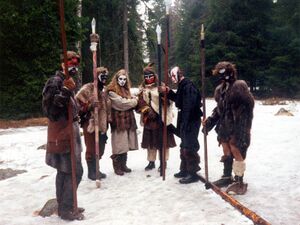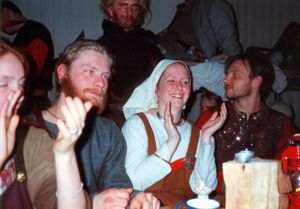Oslo Winterlarps

The Oslo Winter Larp tradition was a genre or series of semi-historic larps played in the Oslo area between 1992 and 2002. These larps would involve reliving the daily life of a certain historic period as central aspect of the frame of the larp. The plotline was often partly mythological marking them as a transitional genrè between the fantasy of the Oslo Summer Larp tradition and the realism of larps such as 1942 and Europa. A tendency towards persistent play and high-resolution role-playing mark these larps as important precursors to the Nordic style, as do their aspirations towards a 360º illusion and an emphasis on cultural simulation and intra-personal relationships at the expense of boffer fights and epic stories.
A typical "vinterlaiv", as it was called in Norwegian, would have between 50 and 100 participants, and be played for four consecutive days during the winter months. Between 1992 and 2002, a vinterlaiv was held almost yearly, usually set to a different historical epoch and organized by an entirely different team than the previous year.
Impact
Early concepts, techniques, and perceptions of playingstyles in Norway are deeply rooted in the everyday situations that arise from playing non-stop for days in a forest, living in cabins heated with firewood, and making and taking food together as a large family, tribe, clan or ætt.
The winterlarps moved the action away from running in the woods with rubber swords into classic home and family situations, including negotiating between groups about marriages, resources or religion. Girls were often more clever and conspicuous than the young male participants in improvising and driving the interaction between the characters in such situations. These larps were a crucial factor for the relative gender-balance of participants in Oslo; they helped recruit a majority of the first female organisers of Norway.
The traditions among both organisers and participants of the Winterlarps in Oslo provided the foundations for iconic larps such as the 2nd World War larp 1942, and the westernlarps Wanted and Once upon a time.
1942 and Once upon a time are included in the Nordic Larp (book).
Playing style

As 360 degree larps, the winterlarps avoided off-game time by including every facet of character life -- including time spent sleeping -- within the game, requiring players to provide seemingly period underwear, nightcaps and the like for a real in-character experience. Non-diegetic items not belonging to a character's environment were banned from the location. This included removing watches, flashlights, cameras, walk-mans and, after some years, beepers and cellphones.
Participants stayed in character while sleeping, eating, and visiting toilets. This made almost every location an active part of the game. Occasionally, players making dinner or doing dishes might make the kitchen temporarily or permanently into a off-game area, but apart from the kitchen and the organisers' own sleeping quarters, the ideal was that all the time and space available would be a part of the larp. Since the cabins were relatively crowded with people, the idea that any indoor location was not part of the diegesis was viewed as limiting to the game. It might not have been a conscious choice of the organisers, but the relatively young playergroup would get so agitated anyway, that it was difficult to ban participants from sneaking around other sleeping players, or from kidnapping people when they went to the traditional outdoor toilets in the dark. On the contrary, the designers of the games promoted these kind of activities, urging participants to play with the borders of the diegesis by the design of secret cults of kidnappers, and by secret ritual brotherhoods that would demand that characters wake up at night to perform secret activities, hidden from each other.
Organizers tested the limits of participants' expectations and their commitment to the diegesis and 360 illusion, for example, by breaking a glass window as a part of the start of the game. In-game, a couple of mercenaries shattered a window and crawled into the kitchen (deemed by a few players by habit to be an off-game space). What really happened was that the participants playing the mercenaries' characters were told to crawl through the open window into the kitchen of the forest cabin in question.
On the inside of the window, inside the kitchen, an organizer waited in the dark with an old window frame. When the mercenaries starting climbing into the window, the organizer banged the old window frame into the floor so the glass broke all over the place, and the racket woke up all the other players. Before anyone noticed, the organizer blended into the many people waking up and start the game and check what was going on inside the kitchen.
Plotlines

In the early years, mythological and religious elements provided 30-50% of the plot elements available for the characters to explore. Characters included normal people of the appropriate historic age, with beliefs and superstitions that came to life through different technology and techniques employed in use by the organizers.
Special character groups used special makeup or costumes to enhance the belief of something supernatural, but in the end, they were most often based on secular explanations. The mysterious Elf in the forest was in the end the mentally retarded child of the parents, that they tried to hide away. The Faeryfolk would be Pictish Tribes from the Scottish highlands interfering with the (main body of players playing) Celtic community.
The difference between summerlarps and winterlarps would be that the vast majority of players would not have access to any magical or supernatural powers. There might be characters like druid or a Norse volve present, but the supernatural would be in the hands of the organisers in forms of sound effects, pyrotechnics like smokemachines, and especially in the form of staged visits of supernatural creatures dressed up and instructed by the organisers.
Over the years the pyrotechnics got less important and the relationship webs between the players took focus. The overall plot lines moved from organizer-driven, to organizer-facilitated, to player-driven and even player-initiated plots.
Techniques
- Scheduling
- Story Arcs
- Recurring scenes (also known as daily routines)
- Ceremonies
- Meetings
- Rituals
- Hierarchies
- Groupplay
- Groupconflicts
- Prewritten characters
- NPCs - (Non Player Characters)
- Relationshipwebs
- Retrospective storylines (Ibsen style, dark secrets from the past is reveiled in the present.)
- Secrecy
- Staging
- Flying Start
- Branching incentivewebs (also at this point in time called "plots" in the Osloscene.)
- Dreamrooms (Early variant of a Black Box or Meta-room)
- Dreaming (Early variant of a Meta-technique)
- Bofferweapons
- Pyrotechnics
- Non-Diegetic Sound
- Players Companion Booklet
- Local Community Description
- SL
- FX
- IL(Personally CharacterDesigner)
- 360
Preparations

Participants were divided into family groups of 10-20 people. Normally the size of the group would match a selected house which would be the base location for this groups play. Participant factions would meet regularly up to 6 months prior to the game, to decide on common clothing, plan for food, special customs or other appropriate exercises. In one game the group playing samipeople memorized some 100 words of Sami and used grammar intended to be totally incomprehensible to the rest of the participants. Skis that would give a period impression were prepared. Old tools were brought to the game. Axes for cutting trees and making firewood. Shovels for digging in the snow.
The evening before the start of the larp, participants would decorate their living quarters, get into costumes, make food and be only partly playing their characters. They might do last minute practice of names of related characters. Individually people would be testing the way of talking in-character, and often practice common songs related to the diegesis or the overall genrè of the larp. More importantly, participants discussed routines such as when to wake up, dishwashing, fetching water, maintaining the fire, and cooking and established time and responsibility for common meals and other practical matters. An organizer would oversee this and balance it with the Scheduling and the Storyarc of the larp.
Origin
These historic larps were held in wintertime, primarily to provide games during the traditional off-season period of the winter holidays. In contrast to their predecessors, the fantasy-based summerlarps, winter larps required rented cabins to protect players from cold weather. The summerlarps' use of tents or pine shelters was inadequate due to the temperature and the snow. Cabins were rented through active larpers with connections to the Norwegian Scout movement [1].
Changing the climate and the physical environment from tents and grass, to snow and cabins affected the content and pace of these games.
Many of these larps were played during the Easter Holidays. Traditionally Norwegian families go into the mountains and visit old family owned cabins or farms during the Easter holidays. The cabins often have poor sanitation facilities, no electricity and are heated with firewood.
These are holidays where the family spends a lot of time outdoor during daytime, and gather around a long table to share common meals evening time. Singing and playing cardgames is often also a part of this holiday. The winterlarps can be viewed as the larpers of Oslos mimicking these traditions into their larp tradition.
Flying Start
- A Winterlarp usually had a typical element of a flying start. Participants would go to bed out of character with the instructions that the larp will start when they wake up. Often the organisers would stage a scene early morning when everybody were asleep that would wake people up and kickstart the story. This would allow the characters a reason to feel alarmed, and also allowing the players excuses within the diegesis for their character to be confused or insecure about how to react believable in character for the first hours of the larp.
List of Larps
- 1992 - Vingulmork 1196 - Set to the era of King Sverre who defied the pope
- 1993 - Kelterlaiven (The larp of the Celts) - Settlement of celts and vikings in north of the British Isles haunted by mythological creatures of those cultures myths.
- 1994 - Vikinglaiven (The larp of the vikings) - Set to the era of the ancestor of the ancient kings of Norway, Halfdan Svarte (Halfdan the Black).
- 1995 - Pestlaiven (The larp of the black death) - Based on old Norwegian folktraditions and faeries.
- 1996 - Bronsealderlaiven (The larp of the bronzeage) - Matriarchical bronzeage society where the male clanleader needs to be sacrificed through a series of rituals
- 1997 - Et vintereventyr - (A winters fairytale) - First pan-Nordic Larp ever, organised parallell to the first Knutepunkt.
- 1998 - no traditional Winterlarp this year, instead 1944 was organised as the first 2nd Wordwar larp (many similarities in playing style)
- 1999 - no Winterlarp this year (it was a year of many other experiments during wintertime, the old crowd went to the 1920ies investigational crimestory larp named Dark Hill Mansion)
- 2000 - Fremmede Drømmer (Alien Dreams) - Based on old Norse myths of the book Edda.
- 2002 - Enigheten - (Historic game Wintertime, but set to the time of industrialisation in Norway) (http://folk.uio.no/mraaum/laiv/enighet-008.jpg)
Documentation
TV-report made by the Youthdepartment of the National Broadcasting of Norway (NRK) in 1992 from the first Oslo Winterlarp {{#ev:youtube|_siS2M_h95g}}
Slideshow of photos from The Black Death larp in 1995 - {{#ev:youtube|nv4OP1I5QnE}}
